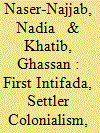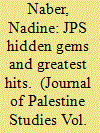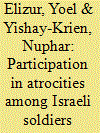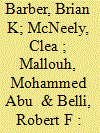|
|
|
Sort Order |
|
|
|
Items / Page
|
|
|
|
|
|
|
| Srl | Item |
| 1 |
ID:
155911


|
|
|
|
|
| Summary/Abstract |
In this reflection on the First Intifada (1987–93), Khalid Farraj recounts his very personal experience as an active member of the uprising. In addition to describing the harsh conditions in Israeli detention at the Ansar 3 prison in the southern Negev, Farraj details the ways in which the uprising was organized at the grassroots, fueling the hopes and dreams of an entire generation of Palestinians. He relates his own arrest in March 1988 during a security sweep of Jalazun refugee camp where he grew up and his work as an activist leafleting and disseminating information among the community. Farraj also provides a glimpse into the workings of the uprising both at the grassroots and at the level of the clandestine local leadership known as the Unified National Leadership of the Uprising (UNLU, al-qiyada al-muwwahida). Despite the letdown subsequent to the Oslo process, which yielded neither self-determination nor liberation for the Palestinians, the First Intifada remains a pivotal moment of Palestinian history, which Farraj looks back on with feeling but without nostalgia. This first-person text was translated from the Arabic by Nehad Khader and Maia Tabet. The original appeared in issue 110 (Spring 2017) of Majallat al-Dirasat al-Filastiniyya.
|
|
|
|
|
|
|
|
|
|
|
|
|
|
|
|
| 2 |
ID:
167959


|
|
|
|
|
| Summary/Abstract |
This article engages with the views of prominent leaders from the First Intifada to evaluate the possibility of a Palestinian uprising under existing circumstances. It provides insight into the past and present to establish a basis for contemporary struggle. In acknowledging the fragmentation of Palestinian land and population, the article argues that many of the features that made popular struggle possible during the First Intifada are now clearly absent, requiring a new praxis of resistance.
|
|
|
|
|
|
|
|
|
|
|
|
|
|
|
|
| 3 |
ID:
178799


|
|
|
|
|
| Summary/Abstract |
This final essay in the “greatest hits” and “hidden gems” series tackles the topic of activism. Noting the richness and diversity of JPS’s contributions in this regard, Nadine Naber hones in on the necessity for hope and for grassroots mobilization at this Palestinian juncture. She exhorts readers to revisit Jonathan Kuttab’s 1988 essay, “The Children’s Revolt,” and Salim Tamari’s article, “The Palestinian Movement in Transition: Historical Reversals and the Uprising,” which appeared in 1991, for both inspiration and edification. Doing so, she argues, “allows readers to reimagine hope as a political ideology and as a set of practices that foster the possibilities for change and decolonization for years to come.”
|
|
|
|
|
|
|
|
|
|
|
|
|
|
|
|
| 4 |
ID:
087573


|
|
|
|
|
| Publication |
2009.
|
| Summary/Abstract |
Atrocities committed by soldiers are a common occurrence that harms not only victims, but also perpetrators, armies, and nations. However, censorship, limited access to information, and the tendency to deny one's evil and project it onto the other impede investigation into how ordinary soldiers cross the line between legitimate fighting and excessive violence. This study examined processes associated with Israeli soldiers' brutal behaviors during the first Intifada. Participants were 21 male combat veterans of two companies stationed in Gaza whose sampling reflected diversity in Israeli society and a wide range of behaviors in the Intifada. Situational factors and social-psychological processes (i.e. modeling, moral disengagement, dehumanization, and deindividuation) were powerful inducers of brutality. The data also showed individual differences in violence, inner-outer directedness, and moral standards. Consequently, five subgroups were identified: Callous/Impulsive, Ideologically Violent, Followers, Restrained, and Incorruptible. The use of these categories to examine the soldiers' unfolding experience over time generated a unique perspective into two less studied dynamics. The first was a synergistic interaction between dispositional and situational factors, manifested in level of brutality and differential subgroup stability of violent behaviors over time. The second was the company as a family-like primary social system that developed inner culture and structural patterns characterized by alignments and social power. Initially, there evolved a culture of brutality with an associated leadership that escalated the violence. A later clash with soldiers who adhered to the army's professional culture transformed the company's culture and structure. This analysis has implications for preventive measures, including the development of morally committed and resolute leadership at both lower and higher echelons of command.
|
|
|
|
|
|
|
|
|
|
|
|
|
|
|
|
| 5 |
ID:
144593


|
|
|
|
|
| Summary/Abstract |
This article summarizes a uniquely thorough study of the first generation of Palestinians to have lived the whole of their lives under occupation. Findings from group interviews and large, representative surveys of men and women from the West Bank, East Jerusalem, and the Gaza Strip in 2011 draw a complex portrait of day-to-day life both currently and historically, including: widespread political activism that they continue to prize; high levels of exposure to often demeaning political violence and restriction of movement; limited access to basic resources, low employment stability and poverty; high levels of social cohesion, but also of lack of safety, political instability, fear for the future, stress, and feeling broken. Most were not optimistic in 2011 about the peace process but remained, confident in their ability to manage what the future brings. The findings also show that each of the three territories has unique types and levels of challenges.
|
|
|
|
|
|
|
|
|
|
|
|
|
|
|
|
|
|
|
|
|